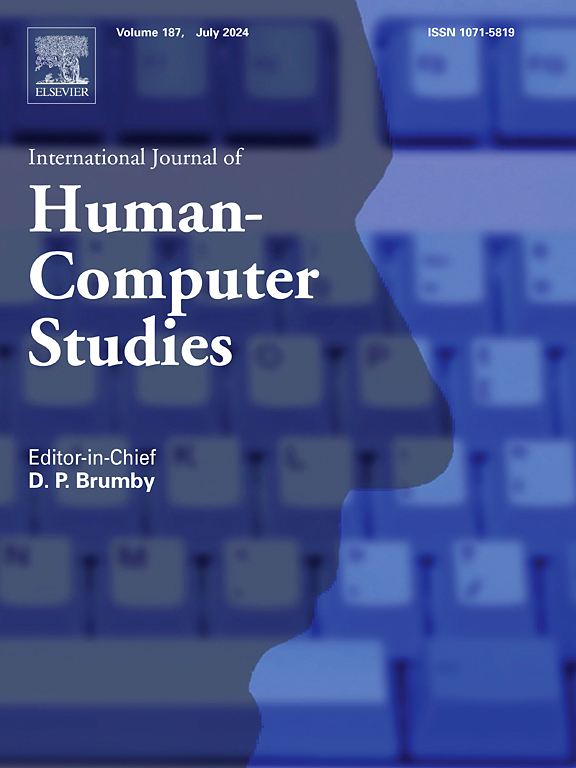Modeling persistence behavior in serious games: A human-centered approach using in-game and text replays
IF 5.1
2区 计算机科学
Q1 COMPUTER SCIENCE, CYBERNETICS
International Journal of Human-Computer Studies
Pub Date : 2025-08-28
DOI:10.1016/j.ijhcs.2025.103601
引用次数: 0
Abstract
Serious Games (SGs) have gained attention as powerful educational tools because of their potential to provide reliable assessments and evaluate hard-to-measure constructs and competencies that are difficult to capture using traditional forms of assessment. Specifically, this study presents a human-centered approach to model and detect persistence — a key component of successful learning outcomes — in the context of SGs. With this purpose in mind, we developed a comprehensive rubric to characterize persistence behaviors in SGs. To design the rubric, we identified a set of persistence profiles and characteristics from previous literature and elaborated a general rubric for identifying persistence behaviors at the level of individual attempts. These characteristics were then mapped onto measurable features within Shadowspect, the SG used for data collection. Following this rubric, two annotators manually labeled 1,374 level attempts from 64 students using two visualization methods: in-game and text replays. With a comprehensive dataset of 2,748 labeled attempts, we trained and evaluated Machine Learning (ML) models for each type of replay to classify persistence behaviors across four categories: Persistence, Non-persistence, Unproductive persistence, and No behavior. Our results indicate that while text-based replays enable efficient annotation with promising performance, in-game replays may provide finer detail for certain complex behaviors, highlighting the strengths and limitations of each visualization method. This work contributes the use of SGs for assessment, illustrating a transparent and adaptable AI-driven approach that enhances reliability and user-centered insights, highlighting the complementary role of human input in optimizing AI-based models to achieve meaningful, user-centered assessments in education.
模拟严肃游戏中的持久行为:使用游戏内和文本回放的以人为本的方法
严肃游戏(Serious Games,简称SGs)作为一种强大的教育工具而备受关注,因为它们能够提供可靠的评估,并评估难以衡量的结构和能力,这是传统评估形式难以捕捉的。具体而言,本研究提出了一种以人为中心的方法来建模和检测持久性-这是成功学习成果的关键组成部分-在SGs背景下。考虑到这一目的,我们开发了一个全面的准则来描述SGs中的持久性行为。为了设计这个准则,我们从以前的文献中确定了一组持久性概况和特征,并详细阐述了一个通用准则,用于在个人尝试的层面上识别持久性行为。然后将这些特征映射到Shadowspect(用于数据收集的SG)中的可测量特征上。根据这个标题,两名注释者使用两种可视化方法(游戏内置和文本回放)手动标记64名学生的1374个关卡尝试。使用包含2748个标记尝试的综合数据集,我们为每种类型的重播训练和评估机器学习(ML)模型,将持久性行为分为四类:持久性、非持久性、非生产性持久性和无行为。我们的研究结果表明,虽然基于文本的重播能够实现高效的注释和有希望的性能,但游戏内的重播可能会为某些复杂行为提供更精细的细节,突出每种可视化方法的优势和局限性。这项工作有助于使用SGs进行评估,说明了一种透明、适应性强的人工智能驱动方法,增强了可靠性和以用户为中心的洞察力,突出了人工输入在优化基于人工智能的模型以实现有意义的、以用户为中心的教育评估方面的补充作用。
本文章由计算机程序翻译,如有差异,请以英文原文为准。
求助全文
约1分钟内获得全文
求助全文
来源期刊

International Journal of Human-Computer Studies
工程技术-计算机:控制论
CiteScore
11.50
自引率
5.60%
发文量
108
审稿时长
3 months
期刊介绍:
The International Journal of Human-Computer Studies publishes original research over the whole spectrum of work relevant to the theory and practice of innovative interactive systems. The journal is inherently interdisciplinary, covering research in computing, artificial intelligence, psychology, linguistics, communication, design, engineering, and social organization, which is relevant to the design, analysis, evaluation and application of innovative interactive systems. Papers at the boundaries of these disciplines are especially welcome, as it is our view that interdisciplinary approaches are needed for producing theoretical insights in this complex area and for effective deployment of innovative technologies in concrete user communities.
Research areas relevant to the journal include, but are not limited to:
• Innovative interaction techniques
• Multimodal interaction
• Speech interaction
• Graphic interaction
• Natural language interaction
• Interaction in mobile and embedded systems
• Interface design and evaluation methodologies
• Design and evaluation of innovative interactive systems
• User interface prototyping and management systems
• Ubiquitous computing
• Wearable computers
• Pervasive computing
• Affective computing
• Empirical studies of user behaviour
• Empirical studies of programming and software engineering
• Computer supported cooperative work
• Computer mediated communication
• Virtual reality
• Mixed and augmented Reality
• Intelligent user interfaces
• Presence
...
 求助内容:
求助内容: 应助结果提醒方式:
应助结果提醒方式:


